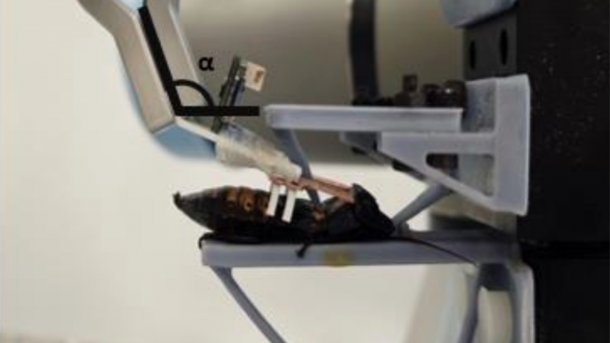Robots automatically convert real cockroaches into cyborgs
An army of cyborg cockroaches could save lives during rescue missions. To do this, however, cockroaches have to be turned into cyborgs en masse.

A cockroach is automatically transformed into a cyborg by a robotic arm.
(Image: Nanyang Technological University)
A research team at Nanyang Technological University in Singapore has developed a method for automatically converting live cockroaches into cyborg cockroaches on a large scale with the help of robots. The cockroaches are fitted with portable stimulation and communication electronics, which can then be used to control the cockroaches remotely.
The approach of controlling cockroaches via electronics attached to the insect in a kind of rucksack is not new. For example, the movement behavior of cockroaches can be influenced from the outside via electronic stimulation of the antennae. This works largely without causing injury to the cockroaches. However, the process of connecting the cockroaches to the electronics is time-consuming and requires some patience and skill. It should take around 30 minutes per insect to establish a connection between the electronics and the probes on the cockroach.
The mechanical engineers at Nanyang Technological University have now found a way to speed up this process. Their aim is to produce hundreds or even thousands of cyborg cockroaches so that they can be used in search and rescue missions during disasters, as the researchers write in the study "Cyborg Insect Factory: Automatic Assembly System to Build up Insect-computer Hybrid Robot Based on Vision-guided Robotic Arm Manipulation of Custom Bipolar Electrodes", which is published in the preprint on Arxiv.
In the study, the researchers describe the basic structure of the "cyborg cockroach factory" and the processes required to "retool" a cockroach. The cockroaches are first exposed to carbon dioxide to put them into a dormant state. They are then automatically fixed in a device with metal rods. The required parts of the insect's body are exposed so that they are easily accessible. Computer vision is used to identify where the connection points for the probes and other electronics are located. A robotic arm can use this information to attach the stimulation and communication technology to the insect. Once this is done, the fixation pins automatically detach from the cockroach and the insect is ready for use.
Faster than manual procedure
According to the scientists, the process takes just 68 seconds, which is significantly faster than a manual procedure. In tests, the scientists were able to prove that the automatically created cyborg cockroaches work at least as well as those created by hand.
However, the scientists are now faced with a new research task: cyborg insects can be produced in large numbers. However, it is still unclear how they can be controlled en masse at the same time. After all, it is not possible to have them controlled individually by one operator. Researchers are therefore looking for a way to control them autonomously depending on their intended use.
(olb)